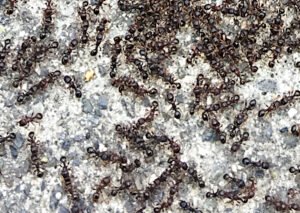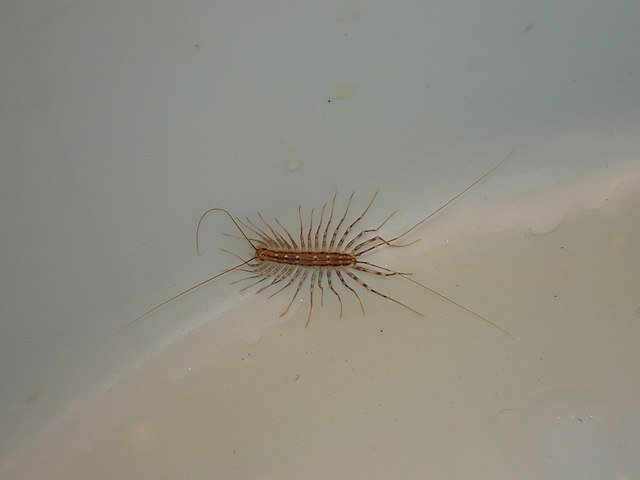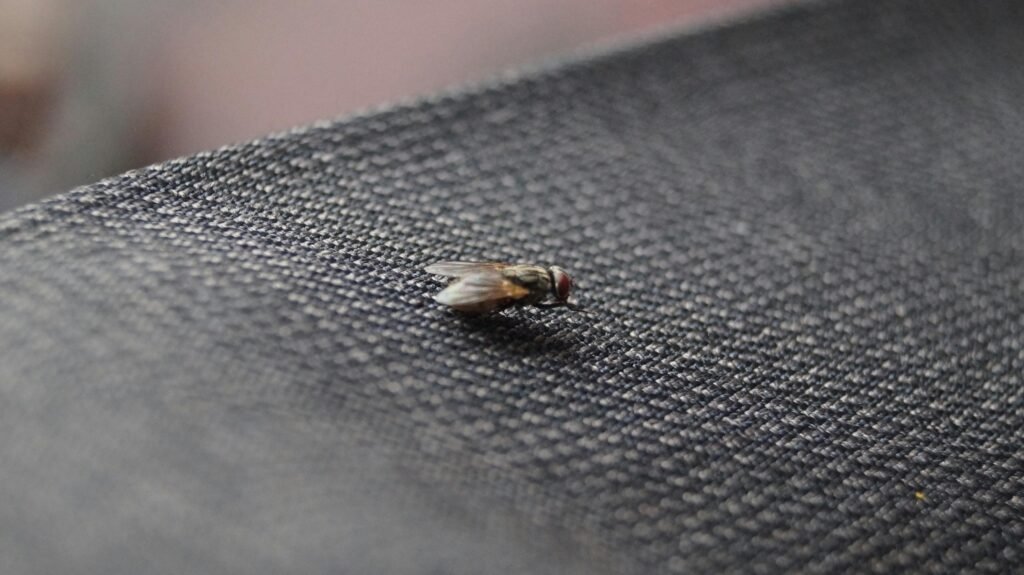Pavement Ants (Tetramorium immigrans): The Tiny Colonizers Beneath Our Feet
 Pavement ants (Tetramorium immigrans) are among the most common urban ants across North America and parts of Europe. As their name suggests, they prefer to nest in cracks of sidewalks, driveways, and building foundations, making them a frequent nuisance for homeowners and businesses. Despite their small size, these ants form large colonies and can become highly persistent invaders of kitchens, pantries, and food storage areas.
Pavement ants (Tetramorium immigrans) are among the most common urban ants across North America and parts of Europe. As their name suggests, they prefer to nest in cracks of sidewalks, driveways, and building foundations, making them a frequent nuisance for homeowners and businesses. Despite their small size, these ants form large colonies and can become highly persistent invaders of kitchens, pantries, and food storage areas.
What makes pavement ants unique compared to other household pests like Ghost ants (Tapinoma melanocephalum) or Pharaoh ants (Monomorium pharaonis) is their adaptability to urban landscapes. They thrive where humans live, using artificial heat sources, paved areas, and abundant food scraps to expand.
This article explores their biology, distribution, risks, and control, while also shedding light on their cultural and ecological significance.
Identification
Correct identification of pavement ants is essential for effective pest control.
Size: Workers are about 2.5–4 mm long.
Color: Typically dark brown to black, with fine parallel lines on the head and thorax.
Antennae: 12-segmented, ending with a distinct 3-segmented club.
Thorax: Uneven with spines pointing backward.
Node: Two nodes between thorax and abdomen, helping distinguish them from species like Carpenter ants (Camponotus spp.).
Behavior: Often seen trailing along sidewalks, foundations, and indoors, especially near food sources.
Winged reproductives (alates) emerge in spring and are often mistaken for Termites (Isoptera). However, ants can be distinguished by their elbowed antennae and constricted waists.
Biology and Ecology
Colony Structure
Pavement ant colonies can house several thousand workers, one or more queens, and developing brood. Queens are responsible for egg-laying, while workers forage and defend the nest.
Nesting Habits
Commonly found under sidewalks, stones, and building slabs.
Soil displaced from nests often forms small mounds visible in pavement cracks.
Colonies expand aggressively, with fights frequently observed between neighboring nests.
Feeding Behavior
Pavement ants are opportunistic omnivores. Their diet includes:
Crumbs, grease, and sugary substances in kitchens.
Dead insects, making them occasional scavengers like Blow flies (Calliphoridae).
Seeds and plant material in outdoor settings.
This broad diet contributes to their resilience in human environments.
Global Distribution
Originally from Europe, Tetramorium immigrans was introduced to North America in the 19th century through maritime trade. Today, they are common across:
North America: Especially in the northeastern and midwestern United States, but also in Canada.
Europe: Widespread in urban areas, often coexisting with Black garden ants (Lasius niger).
Other regions: Documented in temperate zones of Asia and Australia due to globalization.
Their success is linked to their preference for urbanized environments where paved surfaces provide stable nesting sites and consistent warmth.
Risks and Damage
While pavement ants are not structural destroyers like termites or carpenter ants, they can cause significant nuisance and contamination risks.
Health Concerns
They crawl across waste areas and food, potentially spreading bacteria.
Though not direct vectors like Fruit flies (Drosophila spp.), they can contaminate kitchens and restaurants.
Property Issues
Unsightly soil mounds on sidewalks, patios, and driveways.
In commercial buildings, they invade food storage and preparation areas, triggering health code violations.
Economic Impact
Infestations in restaurants, bakeries, and hospitals may result in reputational damage, financial losses, and need for professional pest control.
Signs of Infestation
Recognizing pavement ant activity early helps prevent large infestations.
Foraging trails: Small, dark ants moving in lines to and from food sources.
Soil mounds: Tiny piles of displaced soil near sidewalks, driveways, and basement floors.
Indoor presence: Ants found in kitchens, especially around sugar, crumbs, and greasy residues.
Swarming: Winged reproductives appearing in spring, often around windows and doors.
Control Methods
DIY Measures
Sanitation: Keep kitchens and food storage areas clean.
Sealing entry points: Caulking cracks around windows, doors, and foundations.
Baiting: Using slow-acting ant baits that workers carry back to the colony.
Professional Treatment
Residual insecticide applications along foundations.
Targeted use of non-repellent insecticides that allow transfer among colony members.
Integrated pest management (IPM), combining sanitation, structural exclusion, and chemical controls.
Advanced Approaches
Biological Control
Some research explores using natural enemies such as parasitic flies and pathogenic fungi. However, widespread use in urban settings remains limited.
Heat and Physical Methods
Steam treatment in commercial kitchens.
Use of vacuuming to remove trails in sensitive environments like hospitals.
Monitoring
Advances in digital pest monitoring may help detect and track colonies using sensors placed in problem areas, similar to rodent monitoring systems.
Cultural and Historical Context
Unlike Pigeons (Columba livia), which hold symbolic value in many cultures, pavement ants rarely feature in folklore. Yet, they illustrate the adaptability of species introduced through human trade.
In some scientific studies, pavement ants have been used as urban bioindicators, reflecting how cities reshape insect biodiversity. Their frequent colony battles, sometimes involving thousands of ants, have even caught public attention in parks and sidewalks, where people watch the skirmishes.
FAQ Section
Q1. Are pavement ants dangerous to humans?
No. Pavement ants do not bite aggressively and their stings are too weak to cause harm. They are mostly a nuisance pest.
Q2. How can I tell pavement ants from carpenter ants?
Carpenter ants are much larger (6–12 mm), have a smooth thorax without spines, and nest in wood. Pavement ants are smaller, darker, and form soil mounds in pavement cracks.
Q3. Why do pavement ants suddenly appear indoors?
They enter buildings in search of food or water, especially during drought or after heavy rain when outdoor food is scarce.
Q4. Do pavement ants damage structures like termites?
No. Unlike termites, pavement ants do not consume wood. Their damage is mainly aesthetic (soil piles) and sanitary (food contamination).
Q5. What’s the best way to eliminate a colony?
Ant baits are the most effective method, since they target the colony at its source. Spraying visible ants usually provides only temporary relief.
Q6. Are pavement ants found worldwide?
Yes, though they are most common in North America and Europe. Their distribution is linked to human trade and construction environments.
Final Thoughts
Pavement ants (Tetramorium immigrans) are a textbook example of how small creatures can dominate urban environments. Though harmless in terms of structural damage, they become a persistent nuisance once they establish trails indoors. Their adaptability to city landscapes, broad diet, and aggressive colony defense explain why they are one of the most common ants found in human settlements.
For homeowners and businesses, the key is vigilance. Early detection, strict sanitation, and targeted baiting can control infestations effectively. In commercial settings, professional pest management using integrated strategies ensures long-term prevention.
By understanding their biology and behavior, we can better appreciate why these ants thrive and how to reduce their impact.
Disclaimer
This article is for informational purposes only. Pest control laws and approved chemicals vary by country. For best results and legal safety, we strongly recommend contacting a licensed pest control professional in your local area. Always make sure that the pest control technician is properly certified or licensed, depending on your country’s regulations. It’s important to confirm that they only use approved products and apply them exactly as instructed on the product label. In most places in Europe, UK, or USA, following label directions is not just best practice—it’s the law.
Author Bio
Nasos Iliopoulos, MSc Agronomist & Certified Pest Control Expert
Scientific Director – Advance Services (Athens, Greece)
Licensed Pest Control Business – Ministry of Rural Development & Food (GR)
References
Penn State Extension – Ant Management Guidelines.
University of Florida IFAS – Urban Ants of Florida.
BPCA (British Pest Control Association) – Ant Control in the Built Environment.
Britannica – Tetramorium Species Overview.
PubMed – Peer-reviewed studies on ant colony structure and urban ecology.


